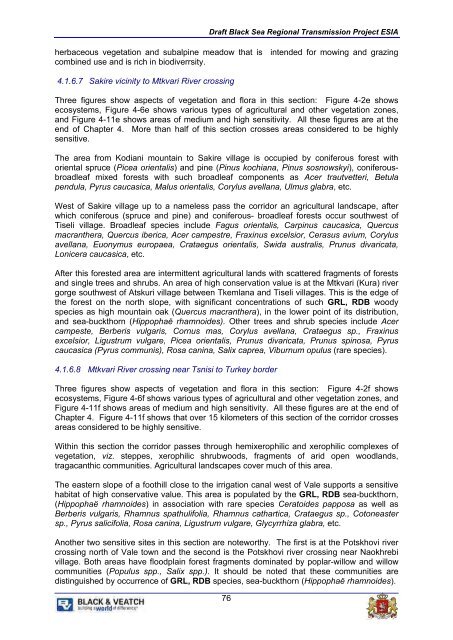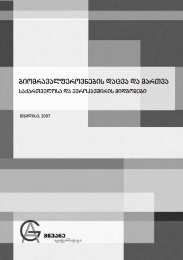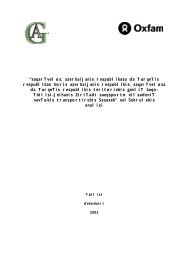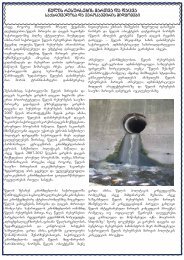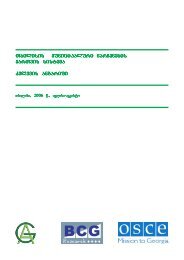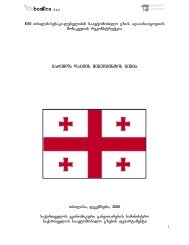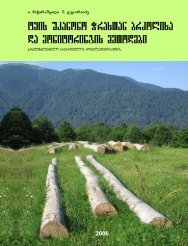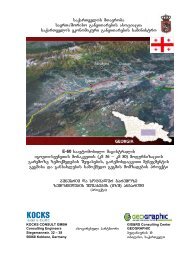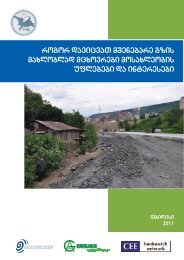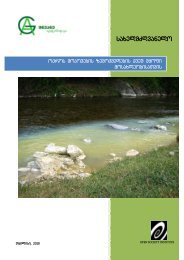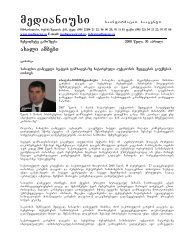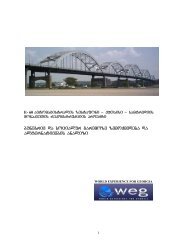Part I
Part I
Part I
You also want an ePaper? Increase the reach of your titles
YUMPU automatically turns print PDFs into web optimized ePapers that Google loves.
Draft Black Sea Regional Transmission Project ESIA<br />
herbaceous vegetation and subalpine meadow that is intended for mowing and grazing<br />
combined use and is rich in biodiverrsity.<br />
4.1.6.7 Sakire vicinity to Mtkvari River crossing<br />
Three figures show aspects of vegetation and flora in this section: Figure 4-2e shows<br />
ecosystems, Figure 4-6e shows various types of agricultural and other vegetation zones,<br />
and Figure 4-11e shows areas of medium and high sensitivity. All these figures are at the<br />
end of Chapter 4. More than half of this section crosses areas considered to be highly<br />
sensitive.<br />
The area from Kodiani mountain to Sakire village is occupied by coniferous forest with<br />
oriental spruce (Picea orientalis) and pine (Pinus kochiana, Pinus sosnowskyi), coniferousbroadleaf<br />
mixed forests with such broadleaf components as Acer trautvetteri, Betula<br />
pendula, Pyrus caucasica, Malus orientalis, Corylus avellana, Ulmus glabra, etc.<br />
West of Sakire village up to a nameless pass the corridor an agricultural landscape, after<br />
which coniferous (spruce and pine) and coniferous- broadleaf forests occur southwest of<br />
Tiseli village. Broadleaf species include Fagus orientalis, Carpinus caucasica, Quercus<br />
macranthera, Quercus iberica, Acer campestre, Fraxinus excelsior, Cerasus avium, Corylus<br />
avellana, Euonymus europaea, Crataegus orientalis, Swida australis, Prunus divaricata,<br />
Lonicera caucasica, etc.<br />
After this forested area are intermittent agricultural lands with scattered fragments of forests<br />
and single trees and shrubs. An area of high conservation value is at the Mtkvari (Kura) river<br />
gorge southwest of Atskuri village between Tkemlana and Tiseli villages. This is the edge of<br />
the forest on the north slope, with significant concentrations of such GRL, RDB woody<br />
species as high mountain oak (Quercus macranthera), in the lower point of its distribution,<br />
and sea-buckthorn (Hippopha rhamnoides). Other trees and shrub species include Acer<br />
campeste, Berberis vulgaris, Cornus mas, Corylus avellana, Crataegus sp., Fraxinus<br />
excelsior, Ligustrum vulgare, Picea orientalis, Prunus divaricata, Prunus spinosa, Pyrus<br />
caucasica (Pyrus communis), Rosa canina, Salix caprea, Viburnum opulus (rare species).<br />
4.1.6.8 Mtkvari River crossing near Tsnisi to Turkey border<br />
Three figures show aspects of vegetation and flora in this section: Figure 4-2f shows<br />
ecosystems, Figure 4-6f shows various types of agricultural and other vegetation zones, and<br />
Figure 4-11f shows areas of medium and high sensitivity. All these figures are at the end of<br />
Chapter 4. Figure 4-11f shows that over 15 kilometers of this section of the corridor crosses<br />
areas considered to be highly sensitive.<br />
Within this section the corridor passes through hemixerophilic and xerophilic complexes of<br />
vegetation, viz. steppes, xerophilic shrubwoods, fragments of arid open woodlands,<br />
tragacanthic communities. Agricultural landscapes cover much of this area.<br />
The eastern slope of a foothill close to the irrigation canal west of Vale supports a sensitive<br />
habitat of high conservative value. This area is populated by the GRL, RDB sea-buckthorn,<br />
(Hippopha rhamnoides) in association with rare species Ceratoides papposa as well as<br />
Berberis vulgaris, Rhamnus spathulifolia, Rhamnus cathartica, Crataegus sp., Cotoneaster<br />
sp., Pyrus salicifolia, Rosa canina, Ligustrum vulgare, Glycyrrhiza glabra, etc.<br />
Another two sensitive sites in this section are noteworthy. The first is at the Potskhovi river<br />
crossing north of Vale town and the second is the Potskhovi river crossing near Naokhrebi<br />
village. Both areas have floodplain forest fragments dominated by poplar-willow and willow<br />
communities (Populus spp., Salix spp.). It should be noted that these communities are<br />
distinguished by occurrence of GRL, RDB species, sea-buckthorn (Hippopha rhamnoides).<br />
76


